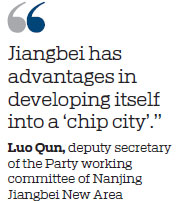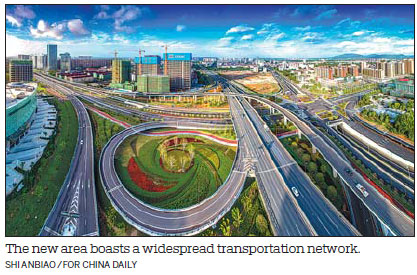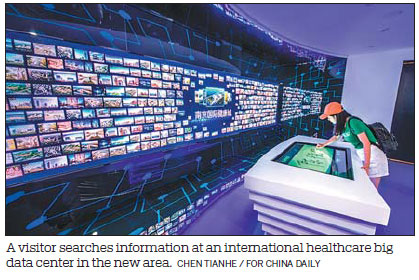New area dares to be different with tech firms' development
Nanjing Jiangbei in Jiangsu province looks to aid growth of Yangtze River Economic Belt
As one of the 19 national-level new areas approved by the State Council, Nanjing Jiangbei New Area in Jiangsu province has unique features and advantages.
It aims to lead the transformation and development of China's eastern coastal regions, which are home to several developed provinces that contribute greatly to the country's GDP.
The new area plans to develop "three zones and one platform". The first zone would be an independent innovation pilot zone. The second, a new urbanization demonstration zone. The third would be a modern industrial cluster zone for Yangtze River Delta. Lastly, the platform is for the opening-up of the Yangtze River Economic Belt.
During a visit to Nanjing Jiangbei New Area in January, Lou Qinjian, the Party chief of Jiangsu, said that the new area should build itself into an innovator to aid the growth of the Yangtze River Economic Belt. Secondly, he said it should become one of the top new areas in the country.
It was made clear that Nanjing Jiangbei New Area will be the second downtown Nanjing in the 2019 government report during the city's two sessions. These were the annual gatherings of the Nanjing People's Congress and the Nanjing People's Political Consultative Conference.

Luo Qun, a member of the Standing Committee of the Nanjing Party committee and the deputy secretary of the Party's working committee of Nanjing Jiangbei New Area, said that the area focuses on emerging fields.
These include integrated circuits (IC), life health and new finance. It is striving to build itself into China's "chip city", "gene city" and a new financial center.
"Jiangbei has advantages in developing itself into a 'chip city'," Luo said. "The 12-inch wafer project of Taiwan Semiconductor Manufacturing Company (Nanjing), which invested $3 billion in the first phase, has been officially mass-produced.
"More than 100 upstream and downstream companies in the IC industry, such as Synopsys, have gathered in Nanjing Jiangbei New Area. More than half of China's top 10 IC design companies have also settled in our area."
The area has formed an industrial chain of chip design, manufacturing, packaging testing and supporting materials. The sales of the area's chip industry aim to reach 100 billion yuan ($14.92 billion) by 2020.
In 2017, the area's GDP topped 200 billion yuan, while in 2018, the figure surpassed 250 billion yuan.
The area has started building a national-level health care big data center and a pilot healthcare big data industrial park. It has built the largest genetic sequencing base in Asia, with an annual sequencing capacity of more than 500,000 person-times.
It has also built the country's fourth super-calculation center. It can crack genetic codes, research new drugs and improve medical technology through major human health data storage and big data analysis.
The area is now home to more than 800 life-health companies. They include industry leaders, such as Shihe Gene and Xiansheng Pharmaceutical. In the area, the output value of the sector is projected to reach 60-70 billion yuan this year.
"The new financial center we're establishing will be different from traditional ones in China, such as Shanghai, and will break away from the traditional financial industry development model," Luo said.
"We will mainly develop new financial formats, such as financial asset management, equity investment, financial technology and insurance innovation. At present, we have gathered more than 100 new financial institutions and more than 80 funds."
By 2020, the scale of funds in the area is estimated to exceed 1 trillion yuan.
Luo said that the area has worked hard to improve education, medical services and infrastructure. It has introduced 34 educational programs and top hospitals in the province and built tunnels and bridges across the Yangtze River.
He also said that professionals are crucial to the area, and that favorable policies have been rolled out to attract and help experts to work in Jiangbei.
The area has been working with many countries and will continue to deepen cooperation with "innovation powers" including the United States, Germany, Britain and Sweden, he said.
"We will offer more preferential policies to attract research centers and functional institutions, build offshore collaborative innovation centers and incubators, and strive to help improve new technologies," he said.
|
A science park at Nanjing Jiangbei New Area in Jiangsu province. Liu Guangxiu / For China Daily |


(China Daily 03/07/2019 page12)















